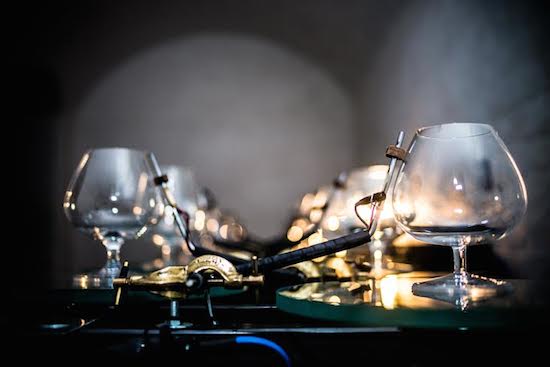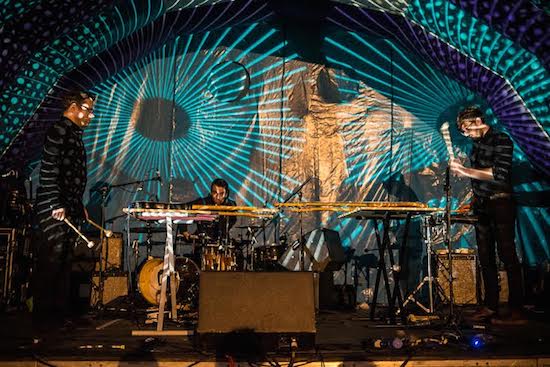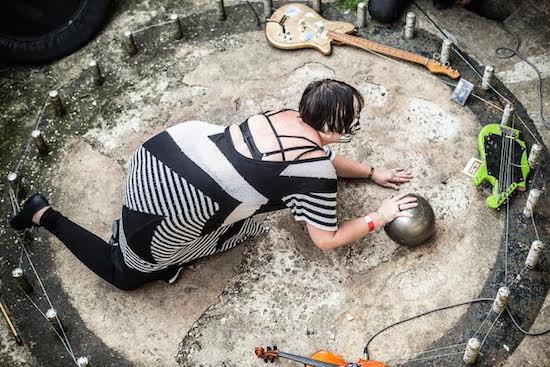Newhaven Fort is an impressive construction, all the more so because it doesn’t loom at you from a distance or dominate the harbour over which it stands. Instead, and almost uniquely, this Victorian Palmerston Fort is built into the contours of its Castle Hill location, adapting to and becoming part of its natural surrounds rather than levelling and conquering them. The battlements and fortifications are effectively at ground level, gun emplacements surrounded by sloping grass and shrubbery, while the parade ground is cut away into the hillside. Much more is hidden beneath the surface, in a network of subterranean tunnels and bunkers, making Newhaven Fort almost invisible, whether approached on foot from the town railway station, or from sea as part of a putative invading armada.
It was concern over the strength of the French Navy in the early 1860s that caused Lord Palmerston–in his second term as Prime Minister- to institute the massive naval defence building programme of which Newhaven Fort was one of the most prominent products. Its unusual design was the work of 22-year-old Lieutenant John Charles Ardagh, who was also the inventor of the Equilibrium Bridge by which the Fort is still entered today. A drawbridge raised and lowered by counterweights, the term ‘Equilibrium Bridge’ to me still sounds like some pan-dimensional gateway out of a Dr Who script, especially given the sense in which entering Fort Process, after walking through sleepy Saturday lunchtime Newhaven town, seems like stepping into another world. Another innovation of Ardagh’s was to make Newhaven Fort the first British military building to be built largely of concrete, arguably rendering it something of an icon of modernism, despite its links to times and conflicts past.
Constructed on the site of a Bronze Age Roman fortification and serving as an important garrison and defence through both world wars, the fort was vacated by the military in 1962 and fell into disuse before being renovated and reopened as a museum in the 1980s. And while the museum naturally focuses on military history and life during wartime, the organisers of Fort Process- a one day festival of experimental music, sound art installations and contemporary classical composition- were more interested in re-appropriating the space, focusing on its unique acoustic and spatial properties and finding out how it adapted to an entirely different function than that for which it was designed.
Themes of modernism, near invisibility and ways in which music- like the Fort- can blend into and work with, rather than against its immediate environment, seem most immediately resonant with today’s event. One of the first sound art installations I come across is Timothy Didymus’ Glass Harmonica Automata in the Expenses Magazine- a concrete bunker set high on the hillside- which is fiendish in its conceptual simplicity but complex and subtle in execution. A dozen brandy glasses, filled to varying levels, are placed on individual glass turntables and attached with contact mics. Fully automated and unattended, as each turntable clicks into or out of motion, a series of eerie whines and ominous tones resonates in the room and out into the clear Sussex air.
A sense of local history is also very much present however, reflecting the psycho-geographical concerns of the festival’s initial instigator Alastair Kemp, founder of Newhaven’s Eleusinian Press and publisher of the Newhaven Journeyman, a journal that explores and connects radical and challenging approaches to music, politics, literature and mental health. In the Fort’s Home Front Room, John Bowers and Tim Shaw sit at their respective desks amid a clutter of electronics, the lights dim, vintage transistor radios positioned around. They could be enigma machine decoders or ham radio enthusiasts, searching for the ghosts of lost airmen or the crackle of numbers stations; in fact they are building up a "sensorium of artistic responses" to the audio signals they pick up in the area, though when I encounter them it’s too early in the project to judge their success.
Moving on up the slope I enter the labyrinthine tunnels of the Grand Magazine, where I find "sonic-visual art collective" Partial Facsimile improvising musically to a film collage representing the industrial development of Newhaven from 1815 to 2015, moving through a decade with every minute and culminating in a ten-minute "future Zone" ending in 2025. With so much going on, and so many performances- particularly the classical pieces- requiring total immersion and concentration, or at least sticking around for the full duration, it’s difficult to do justice to many of the artists here today, particular early on when I’m still hopping around trying to assess the scope of the event and take as much in as possible. And the Fort itself is as much a featured artist as anyone or anything else, so while I technically miss the opening performance of Michael Finnissy’s specially-commissioned Martha Gunn on the main stage, the sound of Helen Whitaker’s pastoral flute drifting up as I look out over the English Channel from the Fort’s highest slopes is a sublime experience in itself.
I do catch Daniel Alexander Hignell’s Hunt Like Men however, performed by a trio featuring two raw, scraping violins and Hignell himself generating resonant, bell-like electronic tones. Later the sight of a lone figure- Barnabas Yianni- performing Alvin Lucier’s 1988 composition for solo amplified triangle, Silver Streetcar For The Orchestra on the inflatable main outdoor stage, to a bemused and largely empty parade ground for a good 30 minutes, is a picture of bathos and quiet bravery.

Venturing into the subterranean Eastern Magazine, down flights of stairs and round winding corridors I come across Joshua Legallienne’s minimalist sound sculptures- blocks of ice melting slowly on plinths- before traversing a claustrophobically narrow and long corridor, sloping uphill like a space between the walls- or worlds. One enclosed underground concrete chamber sounds like it is experiencing a heavy rainstorm, thanks to Swiss artist Zimoun’s entrancing audio installation of 50 motorised rotating aluminium wires. Nearby, ball bearings on stiff wires vibrate against rusting metal plates in Max Eastley’s kinetic sound sculpture.
Descending deeper into the Caponier, at the end of a long deep tunnel, six foot high at the peak of its flaking arch I find a giant bell waiting to be rung, like the bell at the end of the world; seated beside it, with eyes serenely closed, a woman waits in ear protectors, mallet on lap, hourglass upturned. This is Frances Crow of Liminal; when the bell is struck it doesn’t quite signal Ragnarok, but echoes dramatically enough along the supposedly haunted corridor. The acoustics of the corridor are further explored by jazz saxophonist John Butcher, whose long breaths on his instrument are astonishing, seemingly overdubbing his own lines in real time.
Emerging into daylight, I am astonished to hear something resembling rock music booming out from the Needle Tunnel, and indeed this turns out to be the incredible NeuroHarp, a drum/fuzz bass duo centred on the NeuroHarp itself- a brainwave controlled musical instrument designed, built and "played" by drummer Jamie Gillett via a headset. Resembling an upturned coffee table strung with tight strings, atop a box of circuitry and a spinning lathe controlled via Gillett’s thought patterns- as I understand it, in a narrow corridor full of bodies and noise and Marshall stacks and flickering neon tubes. Anyway, it sounded great, a vibrating industrial drone complimenting and subverting the dirty rock.
There’s more Marshall stack abuse from Joshua Legallienne in the school room, flaying his guitar at ear-splitting- not to mention ground-shaking, sphincter-opening, chest-cavity-crushing- volume alongside fellow local noise-mongers Infinite Gaa’aah and Cal-Mag, as Infinite Cal-Mag (le) Gaa’aahlienne, naturally. People are lying on the floor and being vibrated upwards into the ether by this mung-worshipping shred, bass and electronics power trio, intent on recreating the close-up sound of a B-52 bomber raid and perfectly complemented by the swirling visual disorientation of the Innerstrings Psychedelic Lightshow.
Earlier I caught noise/performance art duo Hysteresis’ vertiginous set in a pit-like gun emplacement at the very top of the fort, looking out over the channel. Disguised as Dazzle Ships in black and white stripes and face masks, Jason Williams and Charlotte CHW make like shadowy drones trapped in a giant ruined pinball machine strung with wires and broken guitars, grey balls colliding to sonic effect while the audience look down from above, as though this is some lost English Hammer Horror prototype of Mad Max Beyond The Thunderdome. In another gun emplacement pit, VA AA LR are making free with firecrackers and pyrotechnics; less flashy (in every sense), but no less impressive is Bela Emerson’s interactive cello performance nearby.
By evening everything coalesces around the main stage and the large Romney Hut for the headline acts. Despite forming in 2009, and acclaimed shows in Japan and Europe, The Artaud Beats are making their debut UK performance tonight. Pianist and singer Yumi Hara Cawkwel is joined by three-fifths of the classic Henry Cow line-up that recorded their 1973 debut Leg End– John Greaves on bass and vocals, Geoff Leigh on flute and electronics, and Chris Cutler on drums. Entirely improvised, their jazz-rock explorations occasionally dip into Beefheart territory, always punchy and slightly feral, often surprisingly melodic (especially when Yumi takes the lead) and never meandering or dull. More shows on British shores, please.

Following a mellow, hypnotically percussive set by Ex Easter Island Head on the main stage, perfectly accompanied by the Innerstrings Lightshow as the sun sets, we move into the Romney Hut for the day’s climax, free jazz legends Peter Brotzmann and Steve Noble. Alternating between saxophone and clarinet, the 73-year-old Brotzmann plays five lengthy pieces to a rapturous response, accompanied by the astonishingly loose-limbed and vigorous Noble on the traps. This is true fire music, fierce and strident but also tuneful and reflective where appropriate, playing with light and shade in the darkened steel bomb shelter. Brotzmann’s craggy, bearded face expands and contracts as he blows, like an old lion asserting his supremacy, and certainly this is no sophomoric skronk assault but a skilled and considered use of noise and harmony, atonal sheets of sound and fragments of melody coalescing over Noble’s rapid, fluttering beats.
Organisers Lost Property excelled themselves at their inaugural festival event, curating a near-impossible convergence of artists and installations in a complex space chosen precisely because of its challenging qualities. As we crossed the Equilibrium Bridge back to reality, we all carried away much to digest and reflect upon in the coming months. A final twist on the Fort’s troubled history, or a joyful new beginning?
<div class="fb-comments" data-href="http://thequietus.com/articles/16277-festival-report-fort-process” data-width="550">


